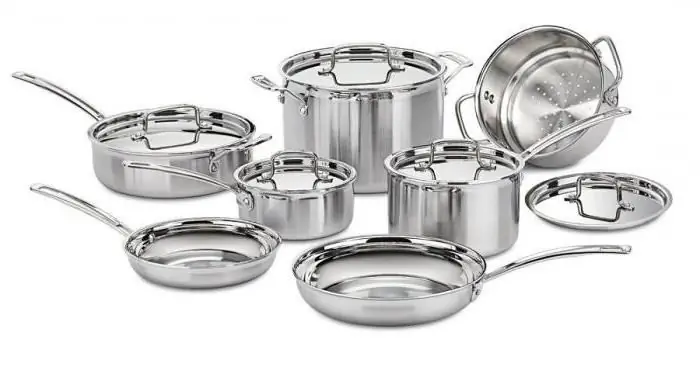2025 Author: Howard Calhoun | [email protected]. Last modified: 2025-01-24 13:10:41
Steels are the most numerous group of metals used, and their marking depends on the classification group.
What are steel grades
Deciphering a brand begins with the definition of its main group by purpose. The following groups of steels are distinguished: structural, construction, tool, with special properties (heat-resistant, heat-resistant and high-strength).

Machine parts, rolled products, welded structures are made from structural steels. Toolboxes, as the name implies, are used to produce a machining tool. A special type of tool steels - high-speed, they are designed for processing at higher loads. Construction steels, used mainly for welded structures, have a low (up to 0.25%) carbon content. The composition is close to structural.
Structural steels
According to their composition, they are divided into alloyed and carbonaceous, that is, with and without special impurities. Alloy steel must contain at least 45% iron. An important property is the presence of foreign non-metallic impuritiesin the resulting alloy - sulfur, phosphorus and others. The less they are contained, the better the metal is considered. There are 4 quality groups in total:
| Group | Maximum harmful impurities | Marking |
| Regular quality | 0.05 % | "St" at the beginning of designation |
| Quality | 0.035 % | "Steel" before designation; most often not written |
| High Quality | 0.025 % | "A" at the end of designation |
| Extra High Quality | 0.015 % | "Ш" at the end of designation |
At the end of the designation, the type of alloy deoxidation can be put down (deoxidation is the removal of oxygen from the steel composition): boiling (KP), semi-quiet (PS), calm (SP). The index "SP" is usually not indicated.
In the general case, the decoding of steels belonging to the alloyed group can be represented as follows:
- [carbon content][alloying elements][deoxidation method][additional characteristics], where the carbon content is written in hundredths of a percent.
Alloying elements are indicated as a combination of their letter designations and percentages. If the content of an element in the alloy is less than a percent, its quantity is not indicated. At presenttime for inclusions, the following designations are used: H - nickel, X - chromium, C - silicon, titanium - T, manganese - G, Yu - aluminum, etc. For example, steel 09G2S contains 0.09% carbon, 2% manganese and silicon in an amount of about 1%. In addition, there are some additional steel grade designations, their decoding is as follows:
1. "Ш" at the beginning - bearing steel.
2. "L" at the end - foundry steel.
3. "A" at the beginning - automatic steel.
4. "E" at the beginning - electrical steel.
Separately allocate building steel grades. The decoding looks like this: the letter "C" is placed at the beginning, after which the yield strength is indicated. The letter "K" means a variant of the chemical composition, "T" - thermal hardening.
Marking steels with special properties is similar to marking structural alloyed steels.
Tool steels

The letter "Y" is placed before the designation, followed by the proportion of carbon (the minimum amount of carbon must be at least 0.7%). Tool steels, like structural steels, are divided into carbon and alloy steels, but they have only 2 quality groups - high-quality and high-quality. In the second case, the letter "A" is placed in the name at the end of the designation. The letter "G" indicates an increased content of manganese. The decoding of steel grades related to tool high-speed cutting is somewhat different. In the first place isthe designation of the entire group is the letter "P" (from the English term "rapid" - fast), then the amount of the main alloying component - tungsten is indicated (its letter designation is omitted).

Indicating the method of steel production
For high-quality alloys, the steel grade production method is indicated at the end of the designation, a breakdown of the manufacturing methods is presented below. These codes are placed at the end of the designation: VD - vacuum-arc; Ш - electroslag; EL - electron beam; VI - vacuum induction.
Recommended:
Food stainless steel: GOST. How to identify food grade stainless steel? What is the difference between food stainless steel and technical stainless steel?

The article talks about grades of food grade stainless steel. Read how to distinguish food stainless steel from technical
Spring steels: characteristics, properties, grades, GOST. Spring steel products

Currently, a lot of different equipment runs on springs, leaf springs, etc. High demands are placed on these details. Spring steels are the appropriate material for their manufacture
How to read steel grades

Alphanumeric codes are used throughout the former Soviet Union. This definition of the steel grade is very convenient and understandable, the number means the percentage of impurities, and the letter means the chemical element
Corrosion resistant steel. Steel grades: GOST. Stainless steel - price

Why metal materials break down. What are corrosion-resistant steels and alloys. Chemical composition and classification according to the type of stainless steel microstructure. Factors affecting pricing. Steel grade designation system (GOST requirements). Application area
Carbon steel grades. Classification, GOST, application

Steel is a ferrous metallurgy product, the main structural material. It is used to produce construction fittings, rolled metal products of various profiles, pipes, parts, mechanisms, tools

